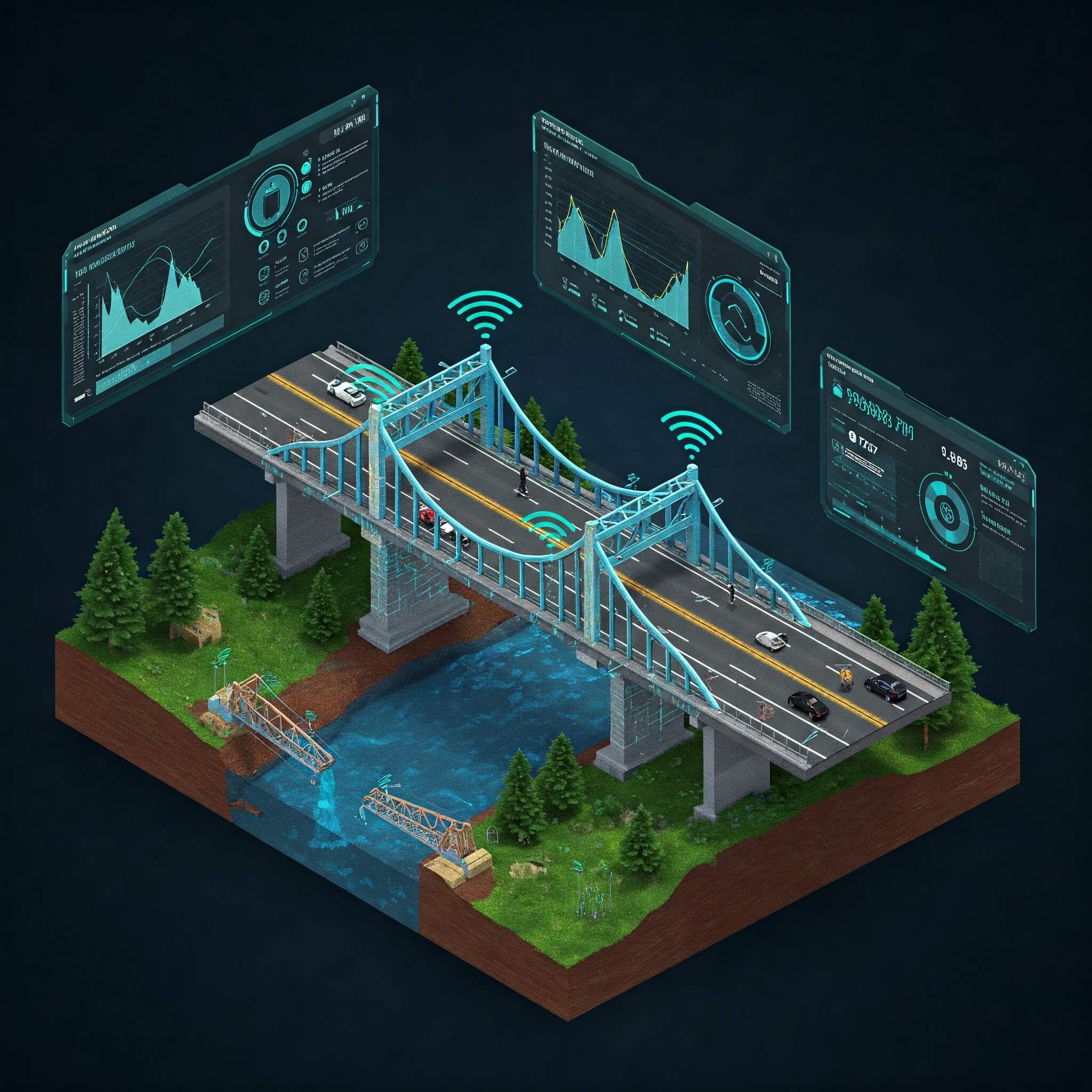The recent advancements in artificial intelligence (AI) and digital twin technology offer a groundbreaking approach to preventing bridge collapses and enhancing infrastructure safety. By creating virtual replicas of physical bridges and integrating them with real-time data and AI-powered analytics, engineers and authorities can now monitor structural health, predict potential failures, and make informed decisions about maintenance and repairs with unprecedented accuracy and efficiency.
Digital twins are virtual representations of physical assets, processes, or systems that are continuously updated with real-time data. In the context of bridge management, a digital twin serves as a dynamic digital counterpart of a physical bridge, mirroring its structure, behavior, and environmental interactions. This virtual replica is built using various data sources, including design models, building plans, inspection reports, sensor data, and historical records. The sensors, acting as the "eyes and ears" of the twin, continuously collect data on vibrations, stress levels, material conditions, wind speeds, temperature changes, and other critical parameters.
AI plays a crucial role in enhancing the capabilities of digital twins. AI algorithms, including machine learning, neural networks, and predictive analytics, analyze the vast amounts of data collected by sensors in real-time. These algorithms can detect patterns, anomalies, and subtle signs of structural weakness that may be missed by traditional inspection methods. By identifying these potential issues early, engineers can address them before they escalate into serious problems, saving millions in maintenance costs and preventing catastrophic failures.
One of the key benefits of AI-powered digital twins is their ability to simulate potential futures. By using machine learning algorithms, the AI can predict potential failure points and estimate the likelihood of a collapse within seconds. This predictive capability allows for proactive maintenance planning, enabling engineers to schedule repairs and reinforcements before a bridge's structural integrity is compromised. Moreover, AI can assess whether the analyses will be effective, and also quantify the uncertainty of the model.
The implementation of AI-powered digital twins in bridge management offers several advantages over traditional methods:
- Real-time monitoring: Digital twins provide continuous, real-time insights into a bridge's structural health, allowing for immediate detection of any deviations from normal patterns.
- Early detection of potential failures: AI algorithms can identify subtle signs of structural weakness that may be missed by visual inspections, enabling timely intervention and preventing catastrophic failures.
- Predictive maintenance: By analyzing historical and real-time data, AI can forecast future conditions and maintenance needs, optimizing maintenance schedules and reducing downtime.
- Reduced downtime: Proactive maintenance planning based on AI predictions minimizes the need for unplanned repairs and closures, reducing traffic disruptions and economic losses.
- Cost savings: Early detection and predictive maintenance can significantly reduce maintenance costs by preventing major structural damage and extending the lifespan of bridges.
- Enhanced safety: AI-powered digital twins improve bridge safety by continuously monitoring structural health, detecting potential issues before they become critical, and enabling timely repairs.
- Improved decision-making: Advanced data analytics and visualization tools provide engineers and authorities with actionable insights for making informed decisions about bridge maintenance and management.
Several real-world case studies demonstrate the effectiveness of AI-powered digital twins in structural health monitoring. The Golden Gate Bridge in San Francisco has implemented AI-based structural monitoring, using sensors to track vibrations, wind speeds, temperature changes, and structural strain. AI algorithms continuously analyze this data, flagging any deviations from normal patterns. Similarly, the Hong Kong-Zhuhai-Macau Bridge utilizes AI technology to monitor its structural health, gathering real-time data on environmental and structural conditions and processing this information to predict maintenance needs and identify risks early.
The University of Florida is developing a groundbreaking digital twin framework, using AI that enables real-time monitoring and efficient decision making related to the maintenance, operation, and management of bridges. This technology combines weigh stations, bridge sensors and AI-powered technologies to improve data collection and provide a clearer picture of a bridge's structural health.
Despite the numerous benefits, the widespread adoption of AI-powered digital twins in bridge management faces several challenges. One of the main hurdles is the integration of disparate data sets from various sources, including design models, sensor data, and historical records. The lack of standardization in data formats and communication protocols can also hinder the seamless integration of different systems. Additionally, cybersecurity concerns and the need for robust data protection measures are crucial considerations for ensuring the safe and reliable adoption of digital twins.
Looking ahead, the future of bridge collapse prevention lies in the continued development and refinement of AI-powered digital twin technology. As AI algorithms become more sophisticated and data collection methods become more advanced, the accuracy and reliability of these systems will continue to improve. The integration of digital twins with other emerging technologies, such as drones, robotics, and augmented reality, will further enhance their capabilities and enable more efficient and cost-effective bridge management.

















